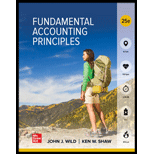
Concept Introduction:
Cash Flow Statements:
Cash flow statements are an integral part of the financial statements of a company. They reflect the direction and movement of the cash inflows and outflows during a reporting period. The cash inflows and outflows are segregated into the following activities:
Cash flows from Investing activities − The cash inflows refer to sales and income from investing activities and cash outflows include cash outflows from the investing activities in the form of purchase of fixed assets and investments.
Cash flows from Financing activities − The cash inflows refer to income from financing activities such as raising share capital and debt and cash outflows include cash outflows from the financing activities in the form of dividends and interest paid.
There are two methods of preparing cash flow statements:
Direct Method − It measures the actual cash inflows and cash outflows that are affected during a particular reporting period. The actual cash flows do not include non-cash items and items that are recorded owing to the accrual principle.
Indirect Method −It measures the cash inflows and cash outflows that are affected during a particular reporting period including the non-cash items and items that are recorded owing to the accrual principle.
Journal entries are the first step in recording financial transactions and preparation of financial statements.
These represent the impact of the financial transaction and demonstrate the effect on the accounts impacted in the form of debits and credits.
Assets and expenses have debit balances and Liabilities and Incomes have credit balances and according to the business transaction, the accounts are appropriately debited will be credited by credited to reflect the effect of business transactions and events.
Effect of transactions on investing activities of cash flow statement.
Want to see the full answer?
Check out a sample textbook solution
Chapter 16 Solutions
FUND.ACCT.PRIN.
- Please explain the solution to this financial accounting problem using the correct financial principles.arrow_forwardPlease help me solve this financial accounting problem with the correct financial process.arrow_forwardRoach and Sulman own a grocery shop. Their first financial year ended on 31 December 19x0. The following balance were taken from the books on that date. Capital - Roach R60000, Suleman R48000 Partnership salaries - Roach R9000, Suleman R6000 Drawings - Roach R12860, Suleman R13400 The first net profit for the year was R32840 Interest on capital is to be allowed at 10% per year Profits and losses are to be shared equally. From the above, prepare the firms appropriation statement and the partners current accountsarrow_forward
- I am looking for the correct answer to this financial accounting problem using valid accounting standards.arrow_forwardI am trying to find the accurate solution to this financial accounting problem with appropriate explanations.arrow_forwardPlease provide the answer to this general accounting question using the right approach.arrow_forward
- Henderson Corporation uses the calendar year as its tax year. It acquires and places into service two depreciable assets during 2024: • Asset #1: 7-year property; $940,000 cost; placed into service on January 20. Asset #2: 5-year property; $410,000 cost; placed into service on August 1. View the MACRS half-year convention rates. Read the requirements. Calculate Henderson's depreciation deductions for 2024. (Use MACRS rates to two decimal places, X.XX%. Round the MACRS depreciation to the nearest dollar.) 2024 Depreciation Asset #1 Asset #2 Total depreciation 134,326 82,000 216,326 Calculate Henderson's depreciation deductions for 2025. (Use MACRS rates to two decimal places, X.XX%. Round the MACRS depreciation to the nearest dollar.) 2025 Depreciation Asset #1 Asset #2 Total depreciation 230,206 131,200 361,406 b. What are Henderson's depreciation deductions for 2024 and 2025 if this is the only property it places into service in those years and Henderson elects Sec. 179 expensing for…arrow_forwardPlease explain the solution to this general accounting problem with accurate principles.arrow_forwardHenderson Corporation uses the calendar year as its tax year. It acquires and places into service two depreciable assets during 2024: • Asset #1: 7-year property; $940,000 cost; placed into service on January 20. Asset #2: 5-year property; $410,000 cost; placed into service on August 1. View the MACRS half-year convention rates. Read the requirements. Calculate Henderson's depreciation deductions for 2024. (Use MACRS rates to two decimal places, X.XX%. Round the MACRS depreciation to the nearest dollar.) 2024 Depreciation Asset #1 Asset #2 Total depreciation 134,326 82,000 216,326 Calculate Henderson's depreciation deductions for 2025. (Use MACRS rates to two decimal places, X.XX%. Round the MACRS depreciation to the nearest dollar.) 2025 Depreciation Asset #1 Asset #2 Total depreciation 230,206 131,200 361,406 b. What are Henderson's depreciation deductions for 2024 and 2025 if this is the only property it places into service in those years and Henderson elects Sec. 179 expensing for…arrow_forward

 AccountingAccountingISBN:9781337272094Author:WARREN, Carl S., Reeve, James M., Duchac, Jonathan E.Publisher:Cengage Learning,
AccountingAccountingISBN:9781337272094Author:WARREN, Carl S., Reeve, James M., Duchac, Jonathan E.Publisher:Cengage Learning, Accounting Information SystemsAccountingISBN:9781337619202Author:Hall, James A.Publisher:Cengage Learning,
Accounting Information SystemsAccountingISBN:9781337619202Author:Hall, James A.Publisher:Cengage Learning, Horngren's Cost Accounting: A Managerial Emphasis...AccountingISBN:9780134475585Author:Srikant M. Datar, Madhav V. RajanPublisher:PEARSON
Horngren's Cost Accounting: A Managerial Emphasis...AccountingISBN:9780134475585Author:Srikant M. Datar, Madhav V. RajanPublisher:PEARSON Intermediate AccountingAccountingISBN:9781259722660Author:J. David Spiceland, Mark W. Nelson, Wayne M ThomasPublisher:McGraw-Hill Education
Intermediate AccountingAccountingISBN:9781259722660Author:J. David Spiceland, Mark W. Nelson, Wayne M ThomasPublisher:McGraw-Hill Education Financial and Managerial AccountingAccountingISBN:9781259726705Author:John J Wild, Ken W. Shaw, Barbara Chiappetta Fundamental Accounting PrinciplesPublisher:McGraw-Hill Education
Financial and Managerial AccountingAccountingISBN:9781259726705Author:John J Wild, Ken W. Shaw, Barbara Chiappetta Fundamental Accounting PrinciplesPublisher:McGraw-Hill Education





